Birds
Media

Species Types
Scientific Name
Dryobates villosus (formerly Picoides villosus)
Description
The hairy woodpecker looks a lot like a downy woodpecker but is larger, with a proportionately longer and stronger-looking bill.
Media
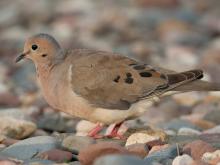
Species Types
Scientific Name
Zenaida macroura
Description
Doves symbolize peace, and they are also a popular quarry of hunters. Our mourning doves are probably the closest living relatives of the extinct passenger pigeon. Learn more about these cooing seed-eaters!
Media

Species Types
Scientific Name
Columba livia
Description
This is the common pigeon of city parks, downtown buildings, barns, and cliffs. Many color forms exist. The wild type has a dark head, breast, and shoulders, a light gray body, two dark bars on the wings, a white rump, and a dark band on the tip of the tail.
Media
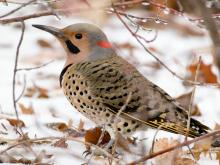
Species Types
Scientific Name
Colaptes auratus
Description
America’s flickers used to be considered three different species, but in the 1980s biologists determined otherwise. Now, our eastern “yellow-shafted” flicker, the “red-shafted” flicker of the west, and the “gilded flicker” of the southwest are all considered just forms of the same species: the northern flicker.
Media
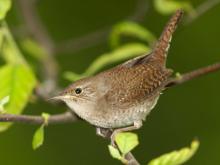
Species Types
Scientific Name
Troglodytes aedon
Description
These audacious little birds are favorite spring arrivals, partly because of their bold bursts of song, but also because of their bold habits around people.
Media
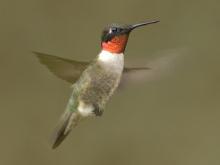
Species Types
Scientific Name
Archilochus colubris
Description
The ruby-throated hummingbird, a tiny bird with a long needlelike bill, is well-known and beloved. It hovers and flies forward and backward with a humming sound. In the light, the male's ruby-red throat shines like a jewel.
Media
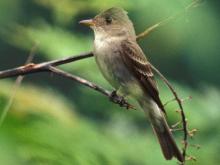
Species Types
Scientific Name
Contopus virens
Description
Its distinctive, slurred “pee-a-wee” song helps differentiate the eastern wood-pewee from our other flycatchers, and from most other small, olive-brown birds.
Media
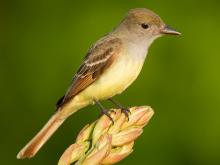
Species Types
Scientific Name
Myiarchus crinitus
Description
The great crested flycatcher spends most of its time high in trees. Learn its distinctive calls, and listen for it in summertime. It’s more common than you might think.
Media

Species Types
Scientific Name
Dumetella carolinensis
Description
Gray catbirds sing jazz solos, improvising nonstop for minutes at a time, quoting the tunes of cardinals, robins, wrens — even frogs or chickens. A catlike “mew” is one of their distinctive notes.
Media

Species Types
Scientific Name
Sayornis phoebe
Description
Eastern phoebes often build their mud-and-plant nests on the side of a house, just under a roof or other overhang. These small flycatchers repeatedly cry out their own name: “FEE-bee! FEE-bee!”
See Also







Media

Species Types
Scientific Name
Hemaris diffinis
Description
The snowberry clearwing is a moth that confuses people because it looks like a bumblebee and flies like a hummingbird!
Media

Species Types
Scientific Name
Hyles lineata
Description
The white-lined sphinx moth sometimes confuses people because it flies, hovers, and eats from flowers like a hummingbird. The adults often fly during daylight hours as well as in the night and are often found at lights.
Media

Species Types
Scientific Name
Darapsa myron
Description
The Virginia creeper sphinx moth is common in woods and brushy areas and comes to lights at night. The larvae eat Virginia creeper and grape leaves.
Media

Species Types
Scientific Name
Perimyotis subflavus (formerly Pipistrellus subflavus)
Description
Tri-colored bats, formerly called eastern pipistrelles, are relatively small and look pale yellowish or pale reddish brown. The main hairs are dark gray at the base, broadly banded with yellowish brown, and tipped with dark brown.
Media

Species Types
Scientific Name
Myotis grisescens
Description
Gray myotises are difficult to distinguish from other mouse-eared bats. A key identifying feature of the gray myotis is that its wing is attached to the ankle and not at the base of the toes. It’s an endangered species.
Media

Species Types
Scientific Name
Myotis lucifugus
Description
The little brown myotis (little brown bat) is one of our most common bats, but populations are declining. White-nose syndrome has taken a heavy toll in northeastern states. This species is now listed as vulnerable across its range.
Media

Species Types
Scientific Name
Myotis sodalis
Description
The Indiana myotis, or Indiana bat, summers along streams and rivers in north Missouri, raising its young under the bark of certain trees. It is an endangered species.
About Birds in Missouri
About 350 species of birds are likely to be seen in Missouri, though nearly 400 have been recorded within our borders. Most people know a bird when they see one — it has feathers, wings, and a bill. Birds are warm-blooded, and most species can fly. Many migrate hundreds or thousands of miles. Birds lay hard-shelled eggs (often in a nest), and the parents care for the young. Many communicate with songs and calls.





















